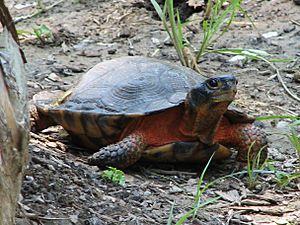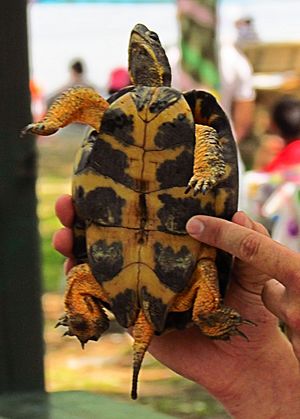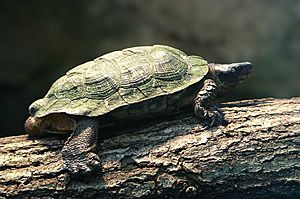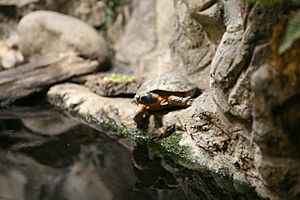Wood turtle facts for kids
The wood turtle (Glyptemys insculpta) is a type of turtle found only in North America. It belongs to a small group of turtles called Glyptemys, which also includes the bog turtle (Glyptemys muhlenbergii). Wood turtles usually grow to be about 14 to 20 cm (5.5 to 8 inches) long. A special thing about them is the bumpy, pyramid-shaped scales (called scutes) on their top shell. They look a bit like the bog turtle, spotted turtle (Clemmys guttata), and Blanding's turtle (Emydoidea blandingii).
Quick facts for kids Wood turtle |
|
|---|---|
 |
|
| Adult specimen | |
| Conservation status | |
| Scientific classification | |
| Genus: |
Glyptemys
|
| Species: |
insculpta
|
Wood turtles live in a wide area, from Nova Scotia in the east to Minnesota in the west and Virginia in the south. Long ago, they were pushed south by large glaciers. Scientists have found old bones of wood turtles as far south as Georgia.
These turtles spend a lot of time in or near wide rivers. They like shallow, clear streams with sandy bottoms. You can also find wood turtles in forests and grasslands, but they usually stay within a few hundred meters of flowing water. They are active during the day and are not very territorial. They sleep through the winter and rest during the hottest parts of summer.
Wood turtles eat both plants and animals (they are omnivores). They can eat food on land or in the water. On a normal day, a wood turtle might travel about 108 meters (354 feet), which is quite far for a turtle! Many other animals in their habitat can be dangerous to them. For example, raccoons are a big threat to wood turtles of all ages. Sadly, humans also cause many deaths through destroying their homes, road accidents, farming accidents, and illegal collecting for pets. If they are not harmed, wood turtles can live up to 40 years in the wild and even 58 years when cared for by humans.
The wood turtle belongs to the family Emydidae. Its scientific name, insculpta, means "sculpted" because of the rough surface of its shell. These turtles live in watery and land areas of North America, mostly in the northeast United States and parts of Canada. Wood turtle populations are a big worry for conservationists because human activities often disturb their natural homes. When their homes are destroyed or broken up, it makes it harder for wood turtles to find mates and build good nests.
Contents
Wood Turtle Family Tree
The wood turtle used to be in the genus Clemmys, but now it's part of the genus Glyptemys. It shares this group with only the bog turtle. The wood turtle and bog turtle have similar genetics. This is a bit different from the spotted turtle (Clemmys guttata), which is the only turtle still in the Clemmys group.
Over time, scientists have given the wood turtle many different scientific names. Today, it has several common names like sculptured tortoise, red-legged tortoise, and redleg.
Even though there are no official types (subspecies) of wood turtles, they do look a little different depending on where they live. Turtles in the western part of their range (like the Great Lakes area) have lighter colors on the inside of their legs and under their necks. Turtles in the east (like the Appalachian Mountains) have brighter colors. Genetic studies also show that southern populations have less variety in their genes than northern ones.
What Wood Turtles Look Like
Wood turtles grow to be between 14 and 20 cm (5.5 to 8 inches) long, measured along their top shell. The longest recorded wood turtle was 23.4 cm (9.2 inches). Their top shell is rough and can be tan, grayish-brown, or brown. It has a ridge down the middle (called a keel) with pyramid-shaped bumps and grooves. Older turtles often have shells that look worn down. Fully grown, they weigh about 1 kg (2.2 pounds).
The larger scales (scutes) on their shell have patterns of black or yellow lines. The wood turtle's plastron (bottom shell) is yellowish with dark patches. The back edge of the bottom shell has a V-shaped notch. The top of their head is usually dark gray to solid black, though sometimes it has yellowish spots. The underside of their neck, chin, and legs are orange to red. Some turtles also have faint yellow stripes along their lower jaw. Their colors can change a bit with the seasons.
When they are fully grown, male wood turtles are larger than females. Males can reach up to 23.4 cm (9.2 inches) long, while females usually reach about 20.4 cm (8 inches). Males also have bigger claws, larger heads, a curved-in bottom shell, a more dome-shaped top shell, and longer tails than females. The bottom shell of females and young turtles is flat, but in males, it becomes curved as they get older. The back scales of females and young turtles stick out more than in adult males. The orange and red colors on the neck, chin, and inner legs are brighter in males than in females, who have a paler yellowish color in these areas.
Baby wood turtles (hatchlings) are about 2.8 to 3.8 cm (1.1 to 1.5 inches) long. Their bottom shells are dull gray to brown. Their tails are usually as long as their top shells, and their necks and legs don't have the bright colors seen in adults. Baby turtles' top shells are also as wide as they are long and don't have the pyramid pattern found in older turtles.
Other turtles that look similar to the wood turtle are the eastern box turtle (Terrapene c. carolina) and Blanding's turtle. All three live in some of the same places. However, unlike the wood turtle, both Blanding's turtle and the eastern box turtle have hinged bottom shells that let them close up completely. The diamondback terrapin (Malaclemys terrapin) has a shell that looks a lot like the wood turtle's, but its skin is gray, and it lives in salty coastal marshes. The bog turtle and spotted turtle are also similar, but neither of them has the special sculpted surface on their top shells like the wood turtle.
Where Wood Turtles Live
You can find the wood turtle in most New England states, Nova Scotia, west to Michigan, northern Indiana, and Minnesota, and south to Virginia. Their populations are often small and spread out. About 30% of all wood turtles live in Canada.
They prefer slow-moving streams with sandy bottoms and lots of plants along the banks. The soft, muddy shores of these streams are perfect for them to spend the winter. Also, the areas next to the streams, which usually have open spaces, are used for nesting. From spring to summer, they spend time in open areas like forests, fields, bogs, wet meadows, and beaver ponds. The rest of the year, they stay in the waterways mentioned earlier.
Scientists have also studied how many wood turtles live in different areas. In the northern parts of their range (like Quebec, Canada), there aren't many, about 0.44 turtles per hectare (about 1 acre). In the south, the numbers vary a lot, from 6 to 90 turtles in the same area. Also, it's been found that groups of wood turtles often have more females than males.
In the western part of their range, wood turtles spend more time in the water. In the east, they spend more time on land, especially during the summer. During this time, they can be found in wooded areas with open tree canopies. However, even here, they are never far from water and will go into it every few days.
How Wood Turtles Evolved
In the past, wood turtle populations were pushed south by large glaciers. Scientists have found old remains from 300,000 to 11,000 years ago in states like Georgia and Tennessee, which are far south of where they live now. After the ice melted, wood turtle groups were able to move back into their usual northern areas, like New Brunswick and Nova Scotia.
Nesting and Reproduction
Wood turtles lay eggs to have their babies. They don't take care of their young after the eggs are laid, except for building the nest. This means that where and how well a nest is built is very important for the babies to survive. Female turtles spend a lot of time and energy choosing and building their nests.
Females choose nest spots based on how warm the soil is, preferring warmer places. The average nest is about 10 cm (4 inches) wide and 7.5 cm (3 inches) deep. Females also build nests in higher areas to avoid floods and predators. After laying their eggs, female wood turtles cover the nest with leaves or dirt to hide the eggs from animals that might eat them. Then, the female leaves the nest until the next mating season. The same female might use the same nesting spot for many years. Because they build nests along rivers, females tend to spend more time near rivers than male turtles.
Wood Turtle Behavior
In the spring, wood turtles are active during the day, usually from about 7:00 a.m. to 7:00 p.m. They are almost always found within a few hundred meters of a stream. They like to look for food in the early morning and late afternoon. During this season, wood turtles use logs, sandy shores, or banks to warm up in the sun. To keep their body temperature just right, they spend a lot of time basking, mostly in the late morning and late afternoon. A wood turtle can reach a body temperature of 37°C (99°F) after basking.
When it's extremely hot, they might rest in shallow puddles or under plants and fallen leaves. In the summer, wood turtles are mostly land animals. At night, their body temperature drops to between 15 and 20°C (59 and 68°F), and they will rest in small creeks or on nearby land, usually in areas with some bushes or grass.
During warmer weather, wood turtles stay in the water more. Because of this, in the winter months (and late fall and early spring), they are considered water turtles. From November through February or March, they hibernate at the bottom of a small, flowing river. A wood turtle might hibernate alone or in large groups. During this time, they bury themselves in the thick mud at the bottom of the river and rarely move. They can be in danger from flash floods during hibernation. They don't come out until March or sometimes April, which is when they become active again. Males are usually more active than females at this time.
Male wood turtles can be aggressive, with larger and older turtles being more dominant. Bigger males are higher up in the social groups that wood turtle colonies sometimes form. In the wild, a weaker turtle might have to run away, or it might get bitten, shoved, or rammed by a stronger turtle. Larger, more dominant males sometimes try to push away a smaller male who is mating with a female. If the smaller male doesn't fight successfully, he will lose the female to the larger male. This means that among males, there's a direct link between how many times they mate and their social rank. However, the winner of a fight between two turtles (male or female) depends more on how aggressive they are than on their size. The turtle that protects its area more fiercely usually wins. Physical fights between wood turtles happen a bit more often in the fall and spring, which are mating times.
Wood turtles eat both plants and animals. They eat things like beetles, millipedes, and slugs. They also eat certain fungi, mosses, grasses, various insects, and even dead animals (carrion). Sometimes, you might see a wood turtle stomping the ground with its front feet, one after the other. People think this behavior sounds like falling rain, which can make earthworms come to the surface, making them easy to catch. When hunting, the wood turtle pokes its head into places like dead logs, under bushes, and in other plants. In the water, they do similar things, searching in algae beds and holes along the sides of streams or rivers.
Many different animals are predators or threats to the wood turtle. These include snapping turtles, raccoons, otters, foxes, and cats. All of these animals destroy unhatched eggs and hunt baby turtles and young ones. Some animals that often target wood turtle eggs are the common raven and coyote, which can completely destroy nests they find. Signs of attacks (like wounds on their skin) are common on wood turtles, but turtles in northern areas tend to have more scars than those in southern areas. Besides these threats, wood turtles can also get leeches.
How Wood Turtles Move
The wood turtle can move quite fast, up to 0.32 km/h (0.2 mph). They also travel long distances during the months they are active. In one study of nine turtles, they traveled an average of 108 meters (354 feet) in a 24-hour period.
Wood turtles are smart animals and can find their way home. Their ability to find directions was shown in an experiment where a turtle found food in a maze. The results showed that these turtles can find locations as well as a rat can. Another experiment also proved this: a male wood turtle was moved 2.4 km (1.5 miles) away after being caught, and within five weeks, it returned to its original spot. The ability to find their way home doesn't change based on whether they are male or female, their age, or the direction they travel.
Wood Turtle Life Cycle
Wood turtles take a long time to become old enough to have babies (14 to 18 years old). They don't have many babies at once, but adult turtles have a good chance of surviving. However, young turtles and hatchlings don't survive as well. Even though males have a social order, they don't defend their territory.
Mating activity for wood turtles is highest in the spring and again in the fall, but they can mate throughout the year when they are active. They have even been seen mating in December. In one rare case, a female wood turtle mated with a male Blanding's turtle, creating a hybrid baby.
The courtship dance can last for several hours and usually happens at the edge of a small stream. Males often start by gently nudging the female's shell, head, tail, and legs. The female might try to get away, and the male will follow. After a chase (if it happens), the male and female will approach and back away from each other, raising and extending their heads. Then, they lower their heads and swing them from side to side. Once they are ready to mate, the male will gently bite the female's head and climb onto her. Mating lasts between 22 and 33 minutes. It usually happens in the water, in depths between 0.1 and 1.2 meters (0.3 to 3.9 feet). Sometimes, it can happen on land, though this is less common. During the main mating times (spring and fall), females might mate anywhere from one to eight times. Because of this, some wood turtle nests have been found to have babies from more than one father.
Nesting happens from May to July. Nesting areas get lots of sunlight, have soft soil, are safe from floods, and don't have many rocks or large plants. However, good nesting spots can be hard to find, so females sometimes travel long distances, even up to 250 meters (820 feet), to find a suitable place. Before laying her eggs, the female might dig several "false" nests. After finding the right spot, she will dig a small hole, lay about seven eggs (though anywhere from three to 20 is common), and then fill the hole with dirt. The eggs are oval and white, averaging 3.7 cm (1.5 inches) long and 2.36 cm (0.93 inches) wide, and weighing about 12.7 grams (0.45 ounces). The nests themselves are 5 to 10 cm (2 to 4 inches) deep, and digging and filling them can take up to four hours. Baby turtles hatch from the nest between August and October. It's rare for them to stay in the nest over winter, but it can happen. Baby turtles are about 3.65 cm (1.44 inches) long and don't have the bright colors of the adults. Female wood turtles usually lay one group of eggs per year and tend to gather around the best nesting areas.
Wood turtles grow quickly during their first few years. Five years after hatching, they are already about 11.5 cm (4.5 inches) long. By age 16, they are fully grown, measuring 16.5 to 17 cm (6.5 to 6.7 inches), depending on if they are male or female. Wood turtles can live for 40 years in the wild, and those in captivity can live up to 58 years.
Conservation Efforts
Even though many wood turtles are seen and they live in a wide area, their numbers are going down. Many turtles die because of humans, due to: their homes being destroyed, farming accidents, and road traffic. Also, they are often illegally collected to be sold as pets around the world. These threats together have caused many areas where they live to create laws to protect them. However, even with laws, it's hard to make sure they are followed and to teach the public about the species.
To properly protect the wood turtle, we need detailed surveys of their homes to find out how many there are. One new idea to help with deaths from cars, which mostly affect nesting females, is building tunnels under roads. These tunnels let the wood turtle cross safely, which helps prevent accidental deaths. Information brochures and other media are being shared to warn people not to keep wood turtles as pets. Also, leaving nests alone, especially common nesting sites, is the best way to help wood turtles survive.
In Canada, the wood turtle is considered threatened. In Nova Scotia, it's listed as vulnerable under the Species at Risk Act. The species is very sensitive to human activities on land. Special ways of managing woodlands, rivers, and farmlands, as well as limits on vehicle use and general protection from disturbances during important times like nesting and moving to winter homes, are carefully watched. Since 2012, the Clean Annapolis River Project (CARP) has done research and worked to protect this species, including finding important habitats, estimating how many there are and how they move, and doing public outreach.
See also
 In Spanish: Galápago de bosque para niños
In Spanish: Galápago de bosque para niños







